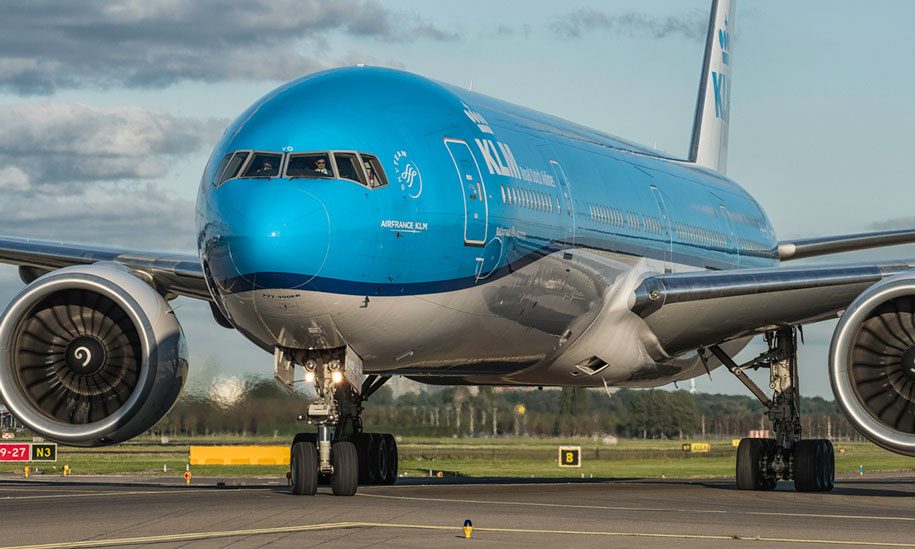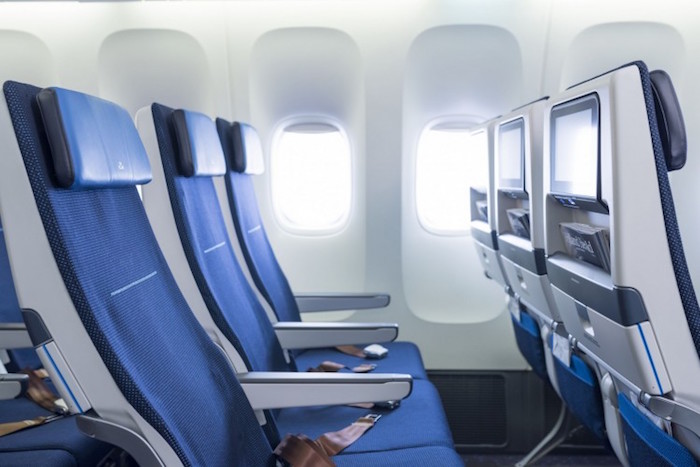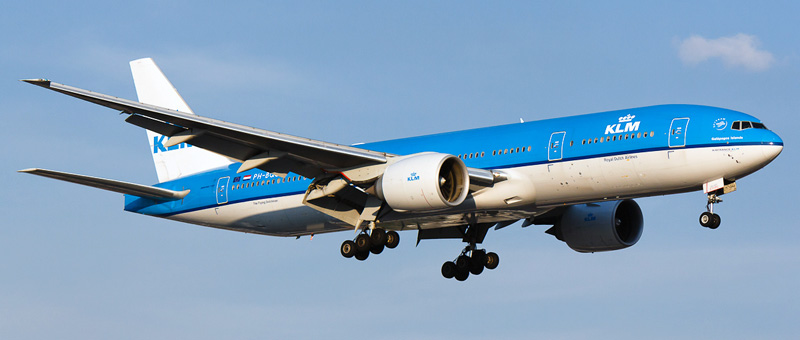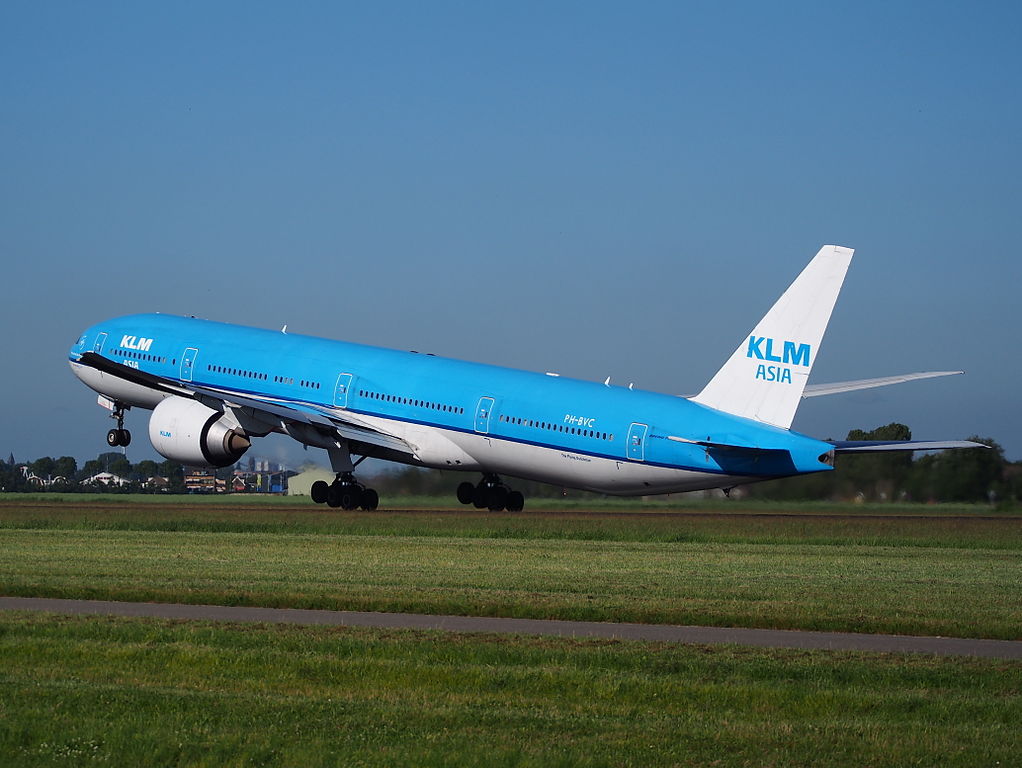Dutch flag-carrier airline KLM operates a fleet of more than a hundred aircraft. The narrow-body fleet is composed of Boeing 737 Next Generation aircraft. Airbus A330, Boeing 777 and Boeing 787 Dreamliner widebody aircraft are used primarily on long-haul missions.[1][2][3]
Current fleet[edit]

- KLM selected the B/E Aerospace Diamond Seats for the 777 World Business Class (the seat is now known as the Collins Aerospace Diamond seat, since B/E became part of the Rockwell Collins group).
- Last week, KLM welcomed its newest Boeing 777-300 featuring an all-new interior in its World Business Class and Economy Class. The exterior has already been.
- KLM Current Fleet
Airbus A330-200
Airbus A330-300
Boeing 737-700
Boeing 737-800
Boeing 737-900
Boeing 777-200ER
Boeing 777-300ER
Boeing 787-9
Boeing 787-10
As of February 2021, the KLM fleet (excluding its subsidiaries KLM Cityhopper, Transavia and Martinair) consists of the following aircraft:[2][3][4]
| Aircraft | In service | Orders | Passengers[4] | Notes | |||
|---|---|---|---|---|---|---|---|
| B | E+ | E | Total | ||||
| Airbus A330-200 | 8 | — | 18 | 36 | 214 | 268 | To be retired in 2025.[5] |
| Airbus A330-300 | 5 | — | 30 | 40 | 222 | 292 | |
| Boeing 737-700 | 18[6] | — | 20 | 6 | 106 | 132 | To be retired in 2022.[7] |
| Boeing 737-800 | 27 | — | 20 | 6 | 150 | 176 | Received the last aircraft of Boeing 737NG series.[8] |
| Boeing 737-900 | 5 | — | 28 | 18 | 138 | 184 | |
| Boeing 777-200ER | 15 | — | 34 | 40 | 242 | 316 | |
| Boeing 777-300ER | 14 | 2 | 34 | 40 | 334 | 408 | |
| Boeing 787-9 | 13 | — | 30 | 48 | 216 | 294 | |
| Boeing 787-10 | 5 | 10[9] | 38 | 36 | 270 | 344 | |
| KLM Cargo fleet | |||||||
| Boeing 747-400ERF | 3 | — | Cargo | Operated by Martinair for KLM Cargo. | |||
| Total | 115 | 12 | |||||

Compare and book your KLM flights and view our special ticket deals and last minutes. Check in online on KLM.com or book a hotel or rental car for your trip. The Boeing 777-300 ER is a twinjet long-haul aircraft with a 11,000 km range with palletized holds forward and rear.
KLM B777-200s are quite old, though a refurbishment is due to all by the end of 2016. Business Class seats are not comfortable. Some single lateral seats would be mandatory, for many a passenger are very impolite.
Historical fleet[edit]
Over the years, KLM has operated the following aircraft types:(list incomplete)[citation needed]
| Aircraft | Total | Introduced | Retired | Notes |
|---|---|---|---|---|
| Airbus A310-200 | 11 | 1983 | 1997 | |
| BAC 1-11-301AG | 1 | 1968 | 1968 | Leased from British Eagle. Operated from Rotterdam to London service in full KLM colours. |
| Boeing 737-200 | 3 | 1988 | 1995 | |
| Boeing 737-300 | 19 | 1986 | 2011 | |
| Boeing 737-400 | 19 | 1989 | 2011 | |
| Boeing 747-200B | 4 | 1971 | 1991 | |
| 1 | 1977 | Crashed as flight KL4805 | ||
| Boeing 747-200M | 7 | 1975 | 1986 | |
| Boeing 747-200B/SUD | 3 | 1985 | 2003 | |
| Boeing 747-200/SUD/SF | 2 | 1998 | 2003 | Converted from two Boeing 747-200M/SUD aircraft. |
| Boeing 747-200M/SUD | 7 | 1985 | 2003 | |
| Boeing 747-300M | 3 | 1983 | 2003 | |
| Boeing 747-400 | 5 | 1989 | 2020 | Retired earlier due to the COVID-19 pandemic. |
| Boeing 747-400M | 20 | 1989 | 2020 | 3 aircraft put back into service for cargo retired in October 2020. |
| Boeing 767-300ER | 12 | 1995 | 2007 | |
| Carley Werkspoor Jumbo | 1 | 1930 | 1940 | Only 1 aircraft was ever built, PH-AFI. |
| Convair 240 | 12 | 1948 | 1959 | |
| Convair 340 | 13 | 1953 | 1964 | |
| De Havilland DH.9 | 4 | 1921 | 1926 | |
| De Havilland DH.16 | 4 | 1920 | 1924 | Leased from Aircraft Transport and Travel. |
| Douglas C-54 Skymaster | 2 | 1945 | 1959 | |
| Douglas C-54A Skymaster | 16 | |||
| Douglas C-54B Skymaster | 3 | |||
| Douglas DC-2 | 19 | 1934 | 1946 | |
| Douglas DC-3 | 58 | 1936 | 1964 | |
| Douglas DC-4 | 6 | 1946 | 1958 | |
| Douglas DC-5 | 4 | 1940 | 1941 | |
| Douglas DC-6 | 8 | 1948 | 1963 | |
| 1 | 1952 | Crashed as flight KL592 | ||
| Douglas DC-6A | 2 | 1953 | 1961 | |
| Douglas DC-6B | 6 | 1952 | 1963 | |
| 1 | 1954 | Crashed as flight KL608 | ||
| Douglas DC-7C | 15 | 1953 | 1966 | |
| Douglas DC-8 | 22 | 1960 | 1983 | |
| 1 | 1968 | Crashed as Viasa flight VA897 | ||
| Douglas DC-8-63 | 11 | 1967 | 1985 | |
| Douglas DC-9-10 | 6 | 1966 | 1989 | |
| Douglas DC-9-30 | 12 | 1967 | 1989 | |
| Douglas DC-9-30C | 6 | |||
| Fokker F.II | 2 | 1920 | 1927 | |
| Fokker F.III | 14 | 1921 | 1930 | |
| Fokker F.VII | 5 | 1924 | 1936 | |
| Fokker F.VIIa | 15 | 1925 | 1940 | |
| Fokker F.VIIb/3m | 10 | 1928 | 1936 | |
| Fokker F.VIII | 7 | 1927 | 1940 | |
| Fokker F.IX | 2 | 1930 | 1936 | |
| Fokker F.XII | 8 | 1931 | 1936 | |
| Fokker F.XVIII | 5 | 1932 | 1946 | |
| Fokker F.XX | 1 | 1933 | 1936 | |
| Fokker F.XXII | 3 | 1935 | 1939 | |
| Fokker F.XXXVI | 1 | 1935 | 1939 | |
| Ilyushin Il-62 | 7 | 1971 | 1972 | Joint operation with Aeroflot. Used for the Tokyo ~ Moscow ~ Amsterdam service.[10] |
| Koolhoven FK-33 | 1 | 1925 | 1927 | |
| Koolhoven FK-40 | 1 | 1929 | 1936 | Only 1 aircraft was ever built: PH-AES. |
| Koolhoven FK-43 | 9 | 1932 | 1940 | |
| Koolhoven FK-48 | 1 | 1934 | 1940 | Used as a trainer aircraft. |
| Lockheed L-049 Constellation | 6 | 1946 | 1950 | |
| Lockheed L-749 Constellation | 13 | 1953 | ||
| Lockheed L-749A Constellation | 7 | 1960 | ||
| Lockheed L-1049C Super Constellation | 11 | 1953 | 1966 | |
| 1 | 1954 | Crashed as flight KL633 | ||
| 1 | 1957 | Crashed as flight KL844 | ||
| Lockheed L-1049G Constellation | 6 | 1966 | ||
| Lockheed L-1049H Constellation | 2 | 1966 | ||
| 1 | 1958 | Crashed as flight KL607-E | ||
| Lockheed L-188C Electra | 12 | 1959 | 1969 | |
| 1961 | Crashed as flight KL823 | |||
| Lockheed Super Electra-14 | 5 | 1938 | 1948 | |
| McDonnell Douglas DC-10-30 | 12 | 1972 | 1995 | |
| McDonnell Douglas MD-11 | 10 | 1993 | 2014 | Last passenger commercial operator. Three aircraft are currently stored. |
| Stearman Hammond Y-1S | 1 | 1937 | 1939 | Used as a trainer aircraft. |
| Vickers V.803 Viscount | 9 | 1957 | 1966 |
Fleet development[edit]
Fleet strategy[edit]
KLM's first of 8 Boeing 787-10 aircraft was delivered on 28 June 2019; it featured 100th anniversary markings.[11]
On 19 June 2013, KLM had ordered 7 Airbus A350-900s. In June 2019, Air France–KLM announced that KLM will not take up any of the group's ordered A350s, because of fleet rationalization purposes.
CEO Ben Smith has announced at Air France's Investor Day (5 November 2019) in Paris that 'in the near future' KLM will only use the 777 and 787 as their long-haul fleet, retiring their 13 A330's. This move would make KLM an all-Boeing airline.[12]
Special liveries[edit]
KLM has several aircraft painted in special liveries; they include:
Klm B777-300er
- PH-BVA, a Boeing 777-300ER, features an orange forward fuselage that fades into the standard blue to commemorate the Netherlands national team's participation in the 2016 Summer Olympics in Rio de Janeiro.[13]
- PH-KZU, a Fokker F70, has been applied with a special livery featuring Anthony Fokker, the founder of Fokker, commemorating the airline's long-standing history with Fokker aircraft and the phase-out of the Fokker 70 aircraft in October 2017.[14]
- Several aircraft bear the silver SkyTeam alliance livery, including PH-BVD (a 777-300ER), PH-BXO (a 737-900), and PH-EZX (a KLM Cityhopper ERJ-190).
- PH-BKA, a Boeing 787-10, features the standard KLM livery with a 100 wrapped around its lettering on the plane, this is because of the 100 years of being an established airline.
See also[edit]
References[edit]
- ^'Our aircraft'. KLM.
- ^ ab'KLM Royal Dutch Airlines'. Airfleets.net. Archived from the original on 18 December 2016. Retrieved 5 December 2019.
- ^ ab'KLM Royal Dutch Airlines Fleet Details and History'. Planespotters.net. Retrieved 5 December 2019.
- ^ ab'Seating plans'. KLM. Retrieved 3 April 2019.
- ^Woerkom, Klaas-Jan van (2019-11-05). 'KLM neemt definitief afscheid van Airbus A330-vloot'. Luchtvaartnieuws (in Dutch). Retrieved 2020-05-22.
- ^https://www.klm.com/travel/aw_en/prepare_for_travel/on_board/our_aircraft/boeing_737_700.htm
- ^Ouden, Huib den (2 July 2018). 'KLM/VNC-deal van start gegaan'. www.fnvcabine.nl (in Dutch). Retrieved 6 July 2018.
- ^'KLM takes delivery of world's last B737-800'. Ch-Aviation. 20 December 2019.
- ^'The Air France - KLM group takes a next step in optimization of the long haul fleet'. Newsroom KLM. Retrieved 24 November 2019.
- ^https://aeroflotarchives.com/ilyushin-il-62.html
- ^Hales-Dutton, Bruce. 'KLM. A Dutch of Class'. Airliner World. October 2019: 94.
- ^'KLM NEEMT DEFINITIEF AFSCHEID VAN AIRBUS A330-VLOOT'.
- ^'#Orangepride: KLM's unique orange aircraft to promote the Netherlands'.
- ^'A Fond Farewell to Fokker - KLM Blog'. 7 June 2017.
KLM operates 2 versions of Boeing 777-300 airplane.
First cabin version of the Boeing 777-300ER (77W) V1
The first version of Boeing 777-300 operated by KLM is the most common among 2 versions.

This airplane may transport 425 passengers in three classes: business, economy comfort and economy.
Business class consists of 5 rows of flat bed seats that have 2-3-2 configuration.

E seats of the business class doesn’t provide easy access to the aisle.
Lack of floor storage during take-off and landing and close location of the galleys and lavatories are the main disadvantages of the seats of the 1st row.
The noise from the galleys located behind will cause discomfort to passengers of the seats of the 5th row. The seats 5A and 5J have no windows.
Economy comfort class offers 40 seats.
Because of the position of the bulkhead the seats 9AB offer extra space for passengers’ legs. However, close location of the galley may cause discomfort, these seats have only one window, are narrower than standard because the tray tables and personal TVs are in the armrests making them immovable and have no floor storage during take-off and landing.
Proximity of the galleys may represent problem for passengers of the seats of the 10th row. Position of the bulkhead provides some extra legroom for passengers of the seats 10DEFG and 10JK. Passengers travelling with infants are often seated on these seats as they have bassinets. As the tray tables and personal TVs are in the armrests the width of these seats is reduced a little. Lack of floor storage during take-off and landing is another disadvantage of these seats.
As there are no seats in front, the seats 11C and 11H have extra legroom. At the same time these seats are often bumped by other passengers passing by for the same reason. Among other disadvantages: lack of floor storage during take-off and landing and reduced width.
Economy class may transport 350 passengers. The seats of the economy class are divided into three sections.
First section has 9 rows of seats that have 3-4-3 configuration.
Passengers of the seats of the 15th row have less personal space because the seats of economy comfort class located in front that are more reclining.
Entertainment equipment stored under C, D and H seats limit the under-seat legroom of these seats.
The main disadvantage of the seats 18A and 18K are missing windows.
Lavatories located behind the seats of the 23rd row may cause inconvenience to passengers of these seats.
Second section of economy class seats consists of 14 rows of seats that also have 3-4-3 configuration. Passengers of the seats of the 30th row will feel comfortable thanks to extra legroom provided by the exit row located in front. However, protrusion of the exit doors restricts the extra legroom of the seats 30a and 30K. Other passengers tend to gather in the area of these seats while waiting to use lavatories causing discomfort to passengers of these seats. As the tray tables are built-in the armrests these seats are a little narrower than standard. Also these seats have no floor storage during take-off and landing. The seats 30BC and 30HJ are designated by KLM as preferred seats to reserve which an extra fee should be paid. Passengers of these seats as well as of the seats 30A and 30K may get cold during the flight by the exits. The seats 30A and 30K are less padded than standard.
The disadvantages of the seats of the 43rd row are: close location of the galley and lavatory and limited recline.
The third section of economy class seats is located behind another exit row.
Thanks to the exit row located in front the seats of the 50th row offer extra legroom. As the exit doors protrude inside passengers of the seats 50A and 50K will have to angle their legs to fully stretch them. KLM designates the seats 50BC and 50HJ as preferred seats for which an additional fee is charged. The seats of the 50th row have the following disadvantages: reduced width, lack of floor storage during take-off and landing, proximity of the lavatory and the cold from exit doors that passengers may feel during the flight.
Due to position of the bulkhead the seats 52DEFG have limited space for passengers’ legs. Among other disadvantages: location of the galley and lavatories in front, no floor storage during take-off and landing and reduced width because the tray tables and personal TVs are in the armrests making them immovable. However, some passengers prefer to have personal TV in the armrests to have possibility to adjust it easily.
As there are no seats behind the seats 58C and 58H are often bumped by service carts and other passengers passing by.
The noise from the galleys and lavatories located behind will cause discomfort to passengers of the seats 62AB, 62D and 63DEFG, 63JK. Because of limited recline the seats 62AB, 63DEFG and 63JK are considered bad seats.
Second cabin version of the Boeing 777-300ER (77W) V2
This version of Boeing 777-300 operated by KLM may accommodate 408 passengers: 34 in business class, 40 in economy comfort and 334 in the economy class.
Business class seats offer flat bed seats that have 180 degree recline and are located in two sections: firs section consists of 5 rows of seats: 4 rows have 2-2-2 configuration and 1 row has 2-2 configuration. Close location of the galleys and lavatory may cause discomfort to passengers of the seats of the 1st and 5th row. Lack of floor storage during take-off and landing is one more disadvantage of the seats of the 1st row.

The second section of business class seats has only 1 row that contains 6 seats. These seats, the seats of the 6th row have the same disadvantage – proximity of the galleys and lavatory.
Klm B777 Business Class
Economy comfort consists of 4 rows of seats that have 3-4-3 configuration. The seats of the 10th row are a little narrower than standard and have no floor storage during take-off and landing.
334 seats of the economy class are divided into three sections. Most of the economy class seats have 3-4-3 configuration.
First section includes 8 rows of seats. Location of the lavatories behind will cause discomfort to passengers of the seats 20G, 20HJK, 21DEFG and 22ABC.
Second section with 14 rows of seats is located behind the exit row. Passengers tend to congregate in the area of the seats 30ABC and 30HJK while waiting to visit lavatories causing discomfort to passengers of these seats. Passengers of the seats 30BC and 30HJ will feel comfortable thanks to additional space for their legs. The legroom of the seats 30A and 30K on the contrary is limited by exit doors. Among other disadvantages of the seats of the 30th row: reduced width and no floor storage during take-off and landing.
Because of the bulkhead position the seats 30DEFG have limited legroom. Also as the tray tables are in the armrests the width of these seats is reduced. Lack of floor storage during take-off and landing is another disadvantage of these seats.
The noise from the galleys and lavatories will cause inconvenience to passengers of the seats of the 43rd row.
The third section of economy class seats is located behind another exit row. The main disadvantages of the seats of the 50th row are: close location of the galleys and lavatories, reduced width and lack of floor storage during take-off and landing. Also, the seats 50A and 50K have limited space for passengers legs due to protrusion of the exit doors. Exit row located in front provides extra legroom for passengers of the seats 50BC and 50HJ.
Due to position of the bulkhead the seats 52DEFG have limited legroom. Location of the galley in front, tray tables built-in the armrests that reduce the seat width and lack of floor storage during take-off and landing are the main disadvantages of these seats.
Due to missing seats behind the seats 52D and 62H are often bumped by other passengers passing by. Another disadvantage of the seat 62H is location of the galleys behind.
Klm B777-200 Lax To Ams
Location of the galleys and lavatory behind is the main disadvantage of the seats 62ABC and of the last 63rd row.